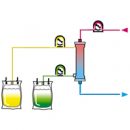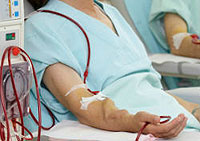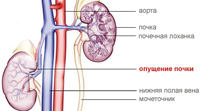Nephroptosis - one in three persons. This means that the disease has three stages, different from each other by their manifestations. Be careful to your body and remember that the first stage of the disease always treats better than all subsequent.
Content
- abdominal ligaments;
- fascia;
- muscles of the abdominal wall;
- supporting kidney bundle.
Of great importance in the preservation of the correct kidney position is played by its fat capsule.
The kidney is an amphibian fiber supports the normal kidney position, and limits its movement. If the amount of fiber decreases sharply - the kidney is lowered and even can be rotated around its axis. In fact, it turns around a vascular beam (renal artery and renal vein).
Miscellaneous, especially fast, one of the factors contributing to the development of nephropotosis. The omission of the kidneys occurs and with a decrease in the muscular tone of the abdominal wall. At the same time, not only the kidney is lowered, but also other abdominal organs. Infectious diseases with damage to the connective tissue, from which ligaments and fascia are also contributed, contributing to nephroptosis. In women, nephroptosis occurs significantly more often than in men. The frequency of nephropotosis in women is 1.5%, in men - 0.1%.
- 1 Stage. In this stage, lowered the kidney can be forgiven through the front abdominal wall on the breath, the kidney exhale leaves in the hypochondrium (in the norm of the kidney can only be forgiven from very thin people, everyone else is not tackling).
- 2 Stage. In the vertical position of the patient, the whole kidney comes out of the hypochondrium, but in the position of lying back in the hypochondrium, or it can be painfully enough to fix it with hand.
- 3 Stage. The kidney completely comes out of the hypochondrium in any position of the body and can shift in a small pelvis.
 Already in the second stage of the kidney, it can turn around its axis, while renal artery and vein are driving and their lumen decreases, except for this vessels stretch. This leads to a decrease in delivery to the kidney of arterial blood (ischemia) and the difficulty of outflow from the kidney of the blood of venous (venous hypertension). In the third stage there may be a resistant blistering of the ureter, which causes a violation of the outflow of urine. Thus, nephroptosis in 2-3 stages can lead to a significant impairment of the blood supply to the kidneys, both arterial and venous. All this makes it easier to develop infection in the kidneys and the emergence of pyelonephritis. Pyelonephritis with nephroptosis often becomes chronic.
Already in the second stage of the kidney, it can turn around its axis, while renal artery and vein are driving and their lumen decreases, except for this vessels stretch. This leads to a decrease in delivery to the kidney of arterial blood (ischemia) and the difficulty of outflow from the kidney of the blood of venous (venous hypertension). In the third stage there may be a resistant blistering of the ureter, which causes a violation of the outflow of urine. Thus, nephroptosis in 2-3 stages can lead to a significant impairment of the blood supply to the kidneys, both arterial and venous. All this makes it easier to develop infection in the kidneys and the emergence of pyelonephritis. Pyelonephritis with nephroptosis often becomes chronic.
Nephroptosis in the first stage may notice imperceptibly. Sometimes there are periodic stupid, buty pains in the lumbar region. More often they increase during exercise and disappear alone, or occur during the transition from horizontal position to vertical. With an increase in the degree of kidney omission, pain is enhanced. Now they can give to the bottom of the abdomen, the crushes.
Starting from the second stage in the kidneys, blood supply is broken, stagnation of urine, it is accompanied by the appearance of protein and red blood cells in the urine.
In the third stage of kidney pain become constant. Due to permanent pain in the patient, depression may occur, neurasthenia. Often nephroptosis is accompanied by a violation of the gastrointestinal tract, a decrease in appetite.In the third stage, with a significant intention of the ureter after exercise, renal colic may occur. Very often, nephroptosis is complicated by the addition of infection (chronic pyelonephritis). Because of the venous hypertension, small veins of the kidneys are overflowing, such veins can be broken on the wall of the cups and pellets, then blood appears in the urine. It often develops arterial hypertension, especially if the renal artery is twisted with nephroptosis. Hydronefrosis develops much less often.
If complications arise, the operational treatment of nephropotosis is carried out - nephropsychia.
The patient's operation prepare for about two weeks. Anti-inflammatory treatment is prescribed to eliminate the possibility of a separation of infection during surgery. 2 - 3 days before the operation of the patient teach to the position lying with a lifted 20 cm of the bed with a foot end. In the same position, the patient will have to be the first few days after the operation.
During the operation, the kidney is fixed at a normal level, but it must maintain normal physiological mobility. Ways to prompt kidney fixation. The type of operation depends on the state of the patient and the skills of the surgeon. After surgery, the patient is prescribed anti-inflammatory treatment for 2 weeks, if necessary, light laxatives. Operational treatment results are usually good. Most patients are recovering. After the operation, patients should limit physical exertion within 6 months.









